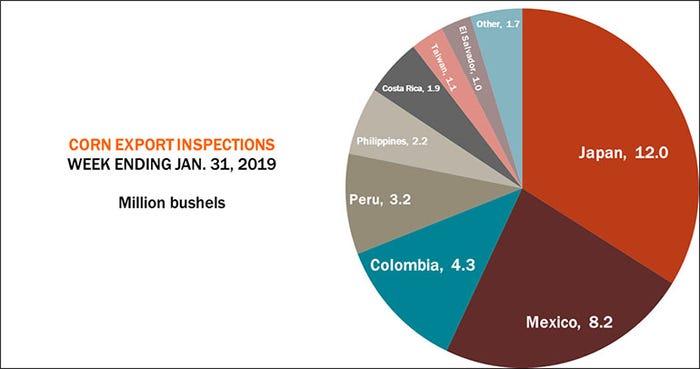
Weekly export inspections for the week ending January 31 provided another mixed bag of data, as soybean and wheat inspections ticked slightly higher from the prior week, with corn totals easing slightly.
One lingering question in the wake of today’s data is whether USDA will adjust its forecasts in Friday’s supply and demand report, according to Farm Futures senior grain market analyst Bryce Knorr.
“Current levels of Chinese demand and sales to other customers suggest USDA’s last soybean estimate, 1.9 billion bushels, could be too high, even with resumed Chinese purchases and lower production in Brazil,” he says. “But there may be too many variables in the mix for USDA to make a change now.”

For now, China has continued to load out some of the soybeans it purchased after trade talks with the U.S. resumed in December, with 15.2 million bushels inspected last week, Knorr adds.
Total U.S. soybean export inspections reached 35.9 million bushels last week, which was just above the prior week’s tally of 34.7 million bushels and in the middle of trade expectations that ranged between 29 million and 40 million bushels. The weekly rate needed to match USDA forecasts held steady at 35.9 million bushels, while marketing year-to-date totals for 2019 continue to trend 38% lower year-over-year.
As Knorr mentioned, China accounted for the most soybean export inspections last week, with 15.2 million bushels. Other top destinations included Mexico (3.1 million), the Netherlands (2.6 million), Spain (2.4 million) and Bangladesh (2.1 million).
Corn export inspections reached 35.5 million bushels last week, easing slightly from the prior week’s total of 38.1 million bushels and on the low end of trade estimates that ranged between 31 million and 43 million bushels. The weekly rate needed to match USDA forecasts moved higher, to 50.5 million bushels. Cumulative year-to-date totals for 2018/19 reached 885 million bushels, trending 51% higher from the pace of 2017/18.
“Corn shipments have tailed off recently as soybean business picked up again but still have a shot at meeting USDA’s forecast for the 2018 marketing year,” Knorr says.
Japan was the No. 1 destination for U.S. corn export inspections last week, with 12.0 million bushels. Other top destinations included Mexico (8.2 million), Colombia (4.3 million), Peru (3.2 million) and the Philippines (2.2 million).
Wheat export inspections totaled 16.2 million bushels last week, moving slightly ahead of the prior week’s tally of 13.5 million but on the low end of trade estimates that ranged between 14 million and 22 million bushels. The weekly rate needed to match USDA forecasts continued to move higher, reaching 25.3 million bushels. Cumulative totals for 2018/19 have reached 545 million bushels, down 11% from the pace of 2017/18.
“Wheat business remains lackluster, but USDA assumes sales will pick up as Russian supplies run thin,” Knorr says. “But Egypt’s latest tender was filled by two rivals, Romania and France, who enjoy lower shipping costs. That could keep lucrative markets in North Africa and the Middle East mostly out of reach to U.S. farmers.”
Last week, Mexico was the No. 1 destination for U.S. wheat export inspections, with 3.9 million bushels. Other top destinations included Nigeria (2.3 million), Egypt (2.3 million), Japan (2.2 million) and the Philippines (2.1 million).






About the Author(s)
You May Also Like






